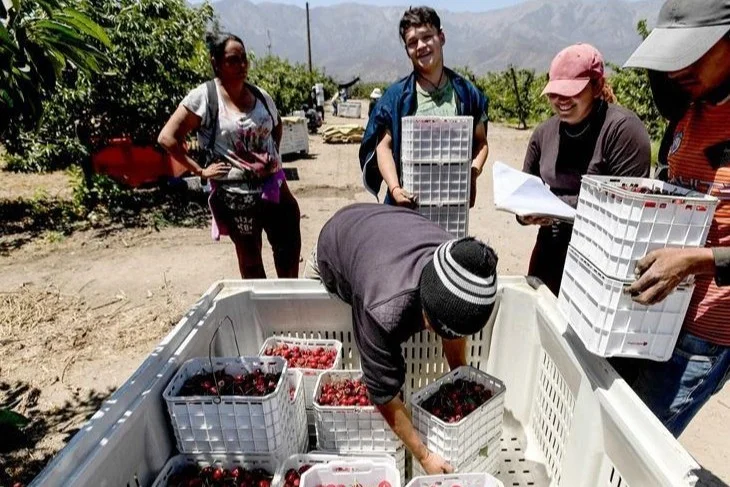When one adapts without a plan, without a narrative, without limits, what is at stake is no longer just business. It is the image a country has of itself.
Every summer, Chile proudly celebrates the success of its cherry: tons exported, record numbers, exclusive charter flights to China, sanitary protocols followed to the letter. On the surface, it all looks like a story of logistical efficiency and agro-export triumph. But for those who have been inside — who have sold fruit, coordinated shipments, negotiated with Chinese importers, corrected labels, and crossed paths with the lunar calendar — the reading changes. It changes completely.
For years I was directly part of that machinery. I exported cherries and other fresh fruit to China. I saw clearly how, little by little, Chile adapted to every external demand without setting any of its own. How harvest times were no longer determined by optimal ripeness, but by the Chinese New Year deadline. How the design of a box, the size of a cherry, or the aesthetics of the color became commercial, cultural, symbolic decisions.
China does not buy fruit. It buys symbols. And Chile, without realizing it, has for years delivered itself symbolically to that game.

Symbols and rituals
China decides when to harvest. It decides how the packaging must look: bright red, imperial gold, auspicious phrases, signs of status. It even decides how it must be consumed: the cherry is not eaten, it is gifted. It is not food, it is a symbolic gesture within guānxì. It is not taste, but prestige and status in giving it. It is part of a social choreography that communicates deference, power, success. It is an object of exchange within a millennial cultural system, where every detail counts, and where everything — even the foreign product — must align with the civilizational DJ setting the rhythm.
The guócháo (国潮) phenomenon — the wave of national pride in Chinese domestic consumption — is not just an aesthetic trend. It is a declaration of power. It is the way in which a civilization activates its cultural apparatus to absorb what comes from outside and transform it into part of its internal narrative. Chile, without realizing it, has adapted to all of this without building any symbolic, aesthetic or strategic defense. It set no conditions. It did not negotiate from its own identity. It did not question. It only adapted.
And when one adapts without a plan, without a narrative, without limits, what is at stake is no longer just business. It is the image a country has of itself.
The illusion of success
From the outside, it might look like we did well. The world sees Chile as a success story in entering the Asian market. But the truth is more uncomfortable: Chile planted cherry trees on autopilot, guided only by the reflection of money.
In just a few years, the country transformed its agricultural matrix without any strategy from the Ministry of Agriculture. It planted in areas without soil studies. Loans were granted without territorial planning. Monoculture was promoted as if the future were guaranteed. Everything revolved around Chinese demand. No one asked what would happen if that demand changed. No one designed sovereignty mechanisms for agro-exports. No one filtered. No one put a brake.
Chile acted as a supplier. Not as a partner. Even less as a negotiator.
And this is the real problem: when there is no plan, no strategy, no clear value of one’s own, there is submission.
Strategies and dependencies
China did not impose a treaty. It did not make public demands. The problem is not China. China does what any civilization with long-term vision does: it sets rules, imposes codes, builds meaning based on its own needs. And Chile — eager to enter that market — accepted each of those conditions without creating its own.
Guānxì (关系) is not a transaction: it is a structure
Talking with Chinese importers means understanding that doing business with China is not selling products. It is entering a network of meanings. It is accepting a model in which business is also personal, political, ceremonial. Where trust is built with time, presence, and loyalty. Where obedience is not requested, but silently expected. Where the relationship does not end with an invoice: on the contrary, that is where it really begins.
And this, in the long term, has a structural cost.
Because it is not just about cherries. It is about what this model sets as the norm.
When a country reconfigures its production matrix without its own plan, without filters, without conditions, it compromises its ability to think about the future with real autonomy.
Productive diversification is lost. Tactical decisions consolidate that were never part of a national strategy. And worse: dependencies are created that are hard to reverse. This is the structural cost: no longer knowing where decisions are taken, nor being able to decide when to change.
Because what we are selling is not fruit. We are exporting adaptability without conditions. We are giving away flexibility without conditions.
Adaptability without sovereignty. We have become the example of how a country can align with another without even participating in the design of that relationship, offering operational submission, executing without questioning.
Who defines the rules?
Who, in this entire process, acted as China’s true counterpart? Where was the State? Who defined the terms of the relationship? Who designed mechanisms to preserve margins, protect agricultural diversity, demand symbolic or commercial reciprocity?
The answer is brutal: no one.
And this omission is strategic. Because when an active policy is not designed, one accepts the other’s structure. In this case, a civilizational structure with centuries of continuity, with an accumulative logic, with living symbols, with a long-term vision of power. Chile, on the other hand, operates with the vision of an agricultural cycle, with the urgency of credit, with seasonal marketing, and with governments that change every four years, rewriting strategies before they mature. It is not a fight among equals. And let me say it plainly: Chile’s institutional discontinuity prevents any long-term strategy in the face of a civilization that plans 30, 50, or 100 years ahead.
Governments change. Ministers change. Priorities change. Even the narratives change.
Meanwhile, China continues to articulate without improvising.
Chile’s institutional discontinuity prevents any long-term strategy in the face of a civilization that plans 30, 50, or 100 years ahead.
Consciousness, structure, symbol
In this context, speaking of “consciousness” is not an abstract concept.
It is literal. China operates from a civilizational consciousness (the ability of a nation to act as a coherent whole over time). From a structure that integrates commerce, aesthetics, ritual, narrative, power.
Chile, on the other hand, moves as an economy, but not as consciousness. It has not created its own symbols. It has not supported structures that represent its narrative in global trade. It has not used its own fruit to project culture, identity, or symbolic sovereignty. It is well known: a product without a narrative, in a world governed by symbols, becomes interchangeable, expendable, and devoid of negotiating power. The Chilean cherry —with all the effort behind it— has positioned itself for counter-seasonality, sweetness, availability. But not for what it represents. It does not tell a story, does not activate imagination, does not build a country brand with narrative power.
And when there is no consciousness, one is absorbed by that of the other.
Chile has become a channel. But a channel without form, without voice, without a vote… becomes invisible. And an invisible country does not negotiate, it only delivers. Will we really continue like this when BRICS advances, when the New Silk Road (One Belt, One Road) consolidates, when the world turns to other power centers? Will Chile claim its place in the room where futures are designed?
Because if one is not there, one is left only to obey another’s script. And that is the difference between being a country… and being a supplier market.
Image source: Xinhua/Jorge Villegas
Fiorella Bonino
China Expert, Vision Magazine
Cherry Times - All rights reserved













